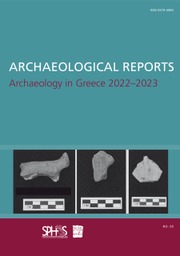Article contents
Introduction & overview
Published online by Cambridge University Press: 10 December 2015
Extract
Does Archaeology in Greece have a purpose? Is it more than a convenient way of logging fortuitous finds? From a newcomer's viewpoint, AG may look hard to put into focus. Why does new information about landscapes and material culture matter? After all, don't we already know a great deal about the remote past of Greece? Aren't museums already full of attractive and interesting things? Do we need more of the same?
Sometimes it pays to play devil's advocate: to stand back, observe what is going on and to take stock. If we want to have a short answer to the above questions, we need go no further than the Newsround section of AG. This year, David Smith bookends the section with key developments that have at least regional, arguably global significance. At one end, we have new data on the presence of early hominids in the Aegean and, at the other end, the report of a 16th -century Spanish galleon from the era of Philip II and the first evidence of a Minoan shipwreck across the Aegean from Crete itself.
- Type
- Archaeology in Greece 2014–2015
- Information
- Copyright
- Copyright © Authors, the Society for the Promotion of Hellenic Studies and the British School at Athens 2015
- 1
- Cited by


